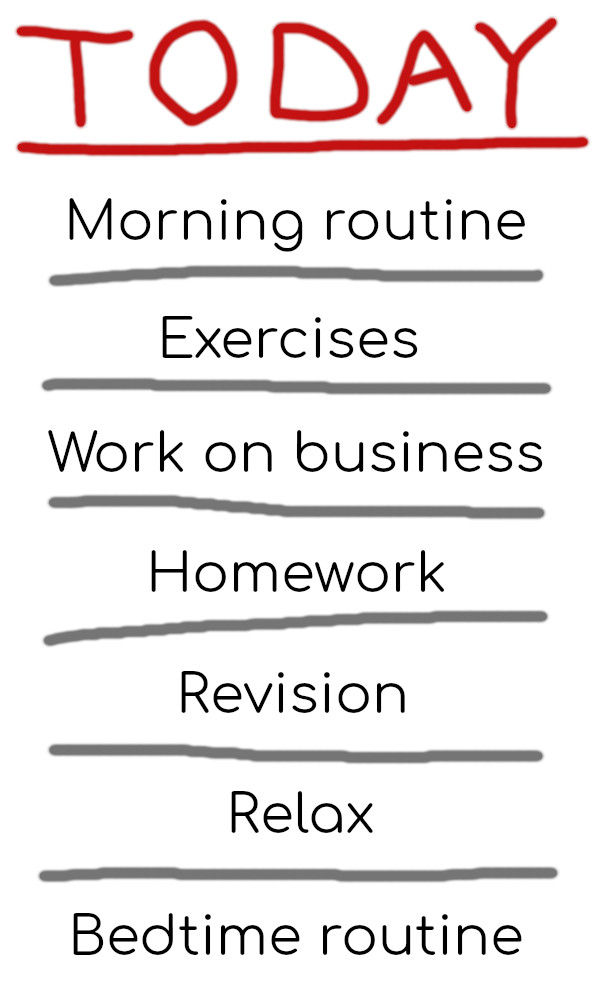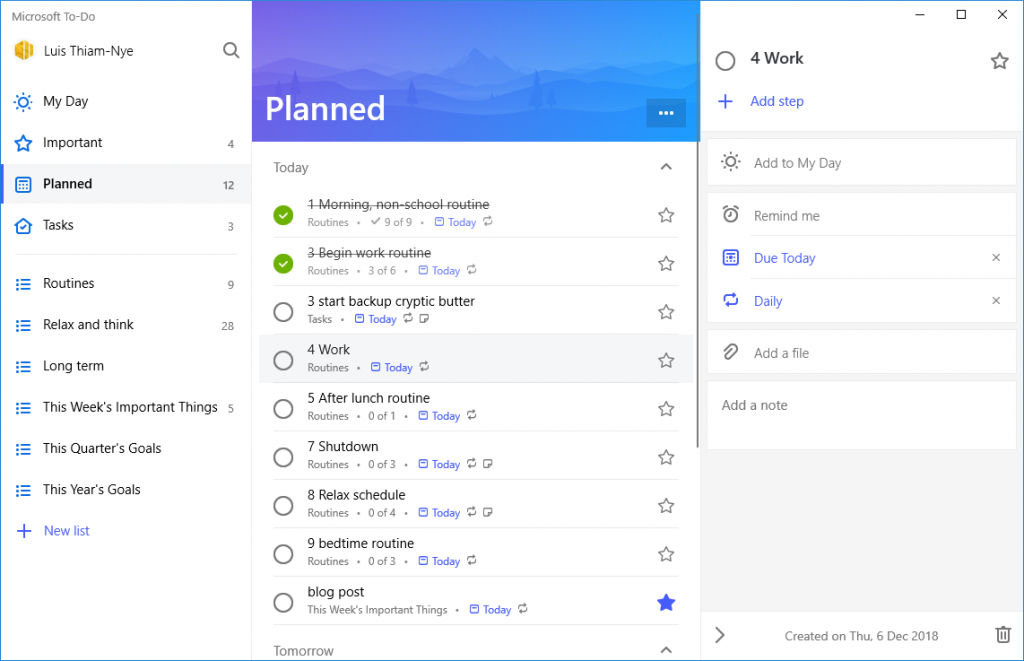insert_linkHow to Not Organise Your Time Effectively
Is your day a mishmash of unrelated tasks unwillingly put together on a rather daunting to-do list? If so, let’s fix that: you need to know how to organise your time for studying sustainably and efficiently.
Also, we’ll be using an indispensable technique referred to as “compartmentalisation”—quite a mouthful, I know.
But what is life like without it—why is there a need for compartmentalisation?
As I alluded to earlier, if you fail to organise the time in your day into distinguished blocks, you thus end up with a mess; while you might have an idea as to what to do in a day, the day itself has no structure.
For example, you could create yourself a daily to-do list that clearly sets out all the activities for the day. However, this is insufficient if you want to manage your time efficiently for studying and other tasks.
How to achieve anything: Why Is Time Management Important for Students?
insert_linkHow Poor Daily Planning Wastes Your Time
What might occur is excessive time wasted due to numerous factors. This is to be expected though, as a disordered day screams unproductiveness and inefficiency.
Frequently switching between totally unrelated tasks does not just waste time; it also harms your performance in tasks, especially mentally-demanding tasks.
Spending too much time planning hurts execution because unstructured time introduces difficulty in deciding what to schedule and when.
Mental exhaustion can kill your productivity in the long term due to a nightmarishly painful plan to follow. Above all, solid habits and routines help preserve willpower—something disorder doesn’t align with.
insert_linkCompartmentalisation: Organise Your Time into Discrete Blocks

Now, the top technique for structuring your day as a student is compartmentalising your time. So, how does it work?
To illustrate, when you list all the tasks you have to do (or, even better, did) in a day, you’ll notice something: activities can be grouped together.
Subsequently, you could determine what those categories are. Then you could assign different parts of the day for different types of activity. Then you could define rules—conditions—for each time block.
Although, I wouldn’t want to overwhelm you just yet.
insert_linkHow I Manage and Organise My Time at Home with Compartmentalisation
Allow me to exemplify compartmentalisation with a day similar to mine. Here are some example tasks that I might do in one day:
insert_linkExample of an (excessive) daily to-do list
- Stretches
- Meditation
- Exercise
- Anki flashcard revision
- Decide what to write an article about
- Write the article
- Do some homework
- Religious studies revision
- Re-write my website’s homepage
- Read email
- Gain some knowledge and consume online content
- Make my website faster
- Daily plan and review
At first, this may look like an extremely intimidating to-do list, but if we are smart about it, that could change. As a consequence of compartmentalisation, I have determined the following time blocks for a free day like this:
insert_linkBreaking up time into time blocks, or partitions
- Wake-up morning routine
- “Morning sector” (after breakfast, transitioning into work)
- Blog work and other non-school work
- Studying
- “Relax and think” time (mostly unscheduled)
- Bedtime routine
Next, I can allocate each task into each partition of my day. Although, it’s not exactly like that; I never generate tasks then compartmentalise them.
To clarify, some of my daily time compartments are fixed, indisputable routines. For instance, there should be no variation in the activities constituting my wake-up morning routine.
Conversely, time blocks 3–5 act as slots for planning my daily tasks. So, firstly, I will determine all of the non-school work I want to do, followed by all study work.
Secondly, I will determine how I will spend my time relaxing (productively), after a day of hard work. In this time chunk, my rule is to forbid any intense and work-related activities.
Optimise your life; never waste time: Is It Possible for You to Be Productive All the Time? (Hint: Yes!)
Finally, we might end up with a daily outline like this (though, note that the routines will be self-explanatory):
insert_linkA complete, clear outline of daily tasks
- Wake-up morning routine
- Meditation
- Exercise
- “Morning sector” (after breakfast, transitioning into work)
- Anki flashcard revision
- Blog work and other non-school work
- Decide what to write an article about
- Write the article
- Re-write my website’s homepage
- Make my website faster
- Studying
- Do some homework
- Religious studies revision
- “Relax and think” time (mostly unscheduled)
- Gain some knowledge and consume online content
- Read email
- Bedtime routine
- Daily plan and review
When you’re organising your time for studying, it better be abundantly clear when your study session starts and finishes. Moreover, you could go further with deeper levels of compartments for even more structured study time!
Also, to strengthen this structure, you would ideally assign specific times for the start and finish of each block—especially routines; things such as work can be more unpredictable hence slightly more flexible.
insert_linkThe Benefits of Organising Your Day into Blocks
Decomposition (breaking things down) is an excellent technique used by programmers to make problems easier to solve. Likewise, we’re using decomposition here to make our days easier to live.

Firstly, you waste less time due to context switching. As a result of grouping related tasks together, the transition between them is less stark. Therefore, you can simply flow from one activity to the next like a gentle river channel.
Secondly, tasks are completed in linear succession, so you avoid the inefficiencies of multitasking. As a basic example, all but a single time block could forbid the use of social media etc.
Thirdly, the daily planning process is significantly more efficient, since half of your day is already pre-determined. Perhaps it’s as simple as drawing important tasks from a long-term to-do list and fitting them into their appropriate time-slot.
Fourthly, a structured day results in sustainable productivity. Freedom of movement of tasks (no time borders in your day) is why you could never organise your time for studying at home for more than a few days.
However, with a clearly defined structure, you’re leveraging the power of habits and routines; after having followed a particular pattern repeatedly, it becomes ingrained in your mind as a normal routine.
Consequently, you’ll find it is much easier to stick to your study plan now and in the future. Also, another contributing factor to this sustained mental performance is the concept of timeboxing.
insert_linkTimeboxing Puts Limits Your Working Hours for More Efficient Study
By taking compartmentalisation further, you can put an artificial limit on how much time you can spend in any given time block. But why on Earth would you want to do that?
While the reasons for the productive nature of timeboxing is a subject for another day, it’s still relevant to compartmentalisation.
Firstly, capping a time block means that you are guaranteed to have time for the others. To illustrate, putting a limit on how long I can work on my website gives me no excuse not to do my homework—in the next time block.
Secondly, it provides variety, whose benefit is twofold: it fights mental exhaustion whilst increasing the efficiency of your work.
Why does timeboxing increase efficiency? Well, it seems like common sense that after innumerable hours of doing the same thing, your concentration will begin to diminish.
This is also why I use the Pomodoro technique, which can be perfectly integrated into your time organisation strategy.
My weekly planning system: How to Be Productive with This Powerful Tool—Guaranteed
insert_linkA Clear Separation Between Work and Play
As I’ve mentioned earlier, each block of time can have its own set of rules. One rule you should implement is to use the Pomodoro technique during all work-related time blocks.

As a result of frequent breaks, your mind is kept tip-top for efficient study sessions and other work.
Likewise, during your relaxation time blocks, you can enforce mental recovery by eliminating a strict schedule. So, no Pomodori; when you relax, you should utilise your time wisely yet casually.
Even though I allocate tasks for my relaxation time block, this is only so I don’t waste time being clueless as to what to do. Thus, even when I’m not being productive, I’m still being productive!
insert_linkDefine Distinct Types of Days
How do you organise your time at home for studying—every day—with the same compartments? Hint: you don’t.
Of course, not every day is the same with regards to planning. Though, that doesn’t mean you couldn’t manage your time wisely all the time.
Unless you are a successful entrepreneur, your time is most likely bound by external restrictions.
To illustrate, most middle-class members have a job, meanwhile, students arguably have more freedom, yet go to school. Furthermore, university students own much more of their time—albeit it will be stolen by additional responsibilities.
For the sake of simplicity, we’ll focus on the traditional UK compulsory education system: five days of school alongside two days of no school.
Looking at this, you immediately have two fundamental categories of days right before your eyes. What’s more, it is entirely possible—in fact, necessary—to divide these categories up further.
To exemplify, if you have an entire day to yourself, you might follow a pattern similar to the earlier example.
On the other hand, if you have school one day, it might be necessary to shorten or even abolish certain routines. Slots for working and studying at home would have to be shortened, too. Moreover, perhaps some types of work can’t exist on certain types of days.
But I can’t tell you what works best for you: experiment yourself based on your circumstances and workflow.

insert_linkTime Boundaries—Why This Structure is Flexible
You might think that rigidly compartmentalising a day is not the best way to organise your time.
While routines occurring at the start and end of your day should definitely be as rigid as feasible, compartmentalisation is not as rigid as you think.
This is because it is designed to clarify what sort of tasks you should be doing at any one point; it does not, however, define exactly what you should be doing down to the very millisecond.
Whereas, without compartmentalisation, you could be doing anything anytime, with it, you must act according to the time block’s rules.
For instance, during your schoolwork time block, anything could be allowed as long as it is homework (or revision etc).
Besides, this assumes there isn’t a clear to-do list; obviously you should know what exact task you should be doing, and compartmentalisation helps you get there. It is, by far, one of the most effective time management techniques to organise your time efficiently.
Schedule your life: Should You Have Faith in Online Calendars? [Kill Procrastination]
insert_linkConclusion
In conclusion, you cannot have time management without a concept of compartmentalisation: it is undeniably fundamental.
It provides structure to help you organise your time for studying and more, yet it is extremely flexible. So flexible that, in fact, it can be used to complement even the least rigid of time management systems.
Setting out clear rules, it gives you the clarity you need in order to make better decisions to spend your time wisely. No more task mishmash!
If it’s work, it’s work, and if it’s time to relax, it’s casual. Sharp. Boundaries.
So, are there any apps I use to implement this strategy? While my system is not currently as formal is perhaps should be, indeed there is.
With a recurring task per compartment, Microsoft To-Do is—at the moment—my compartmentalisation manager of my choosing. Furthermore, within each task, I have sub-tasks to outline routines and tasks only repeat on certain days.
Accordingly, once I’m done with a time block, I merely tick it off (making sure all sub-tasks are completed).

insert_linkThis Week’s Book Recommendation
Pleasantly insightful into the art of planning, this book will be sure to enlighten you:
Eat That Frog! 21 Great Ways to Stop Procrastinating and Get More Done in Less Time
And finally, a question to you, to which you can answer in the below comments:
How would you compartmentalise your time?



